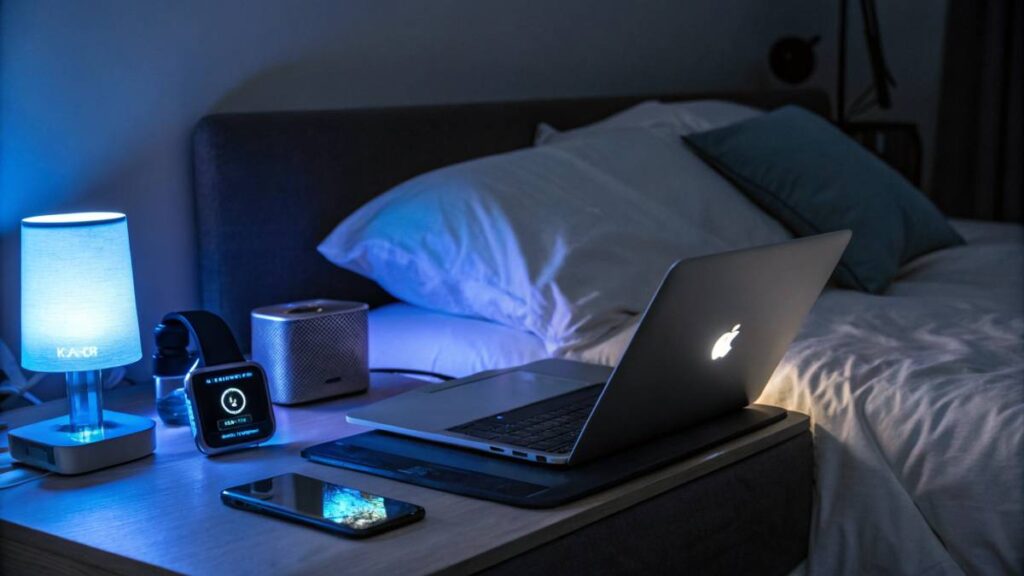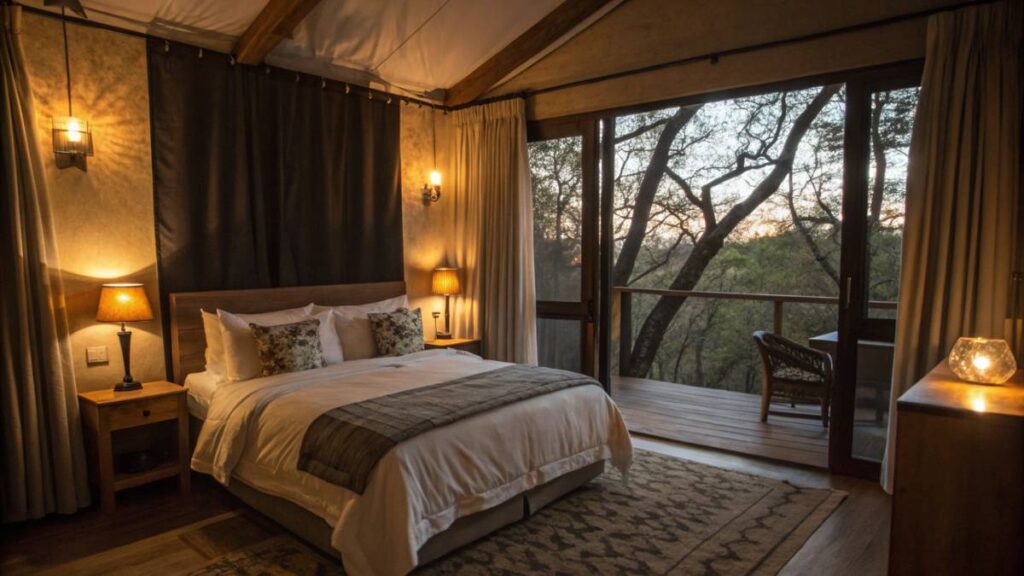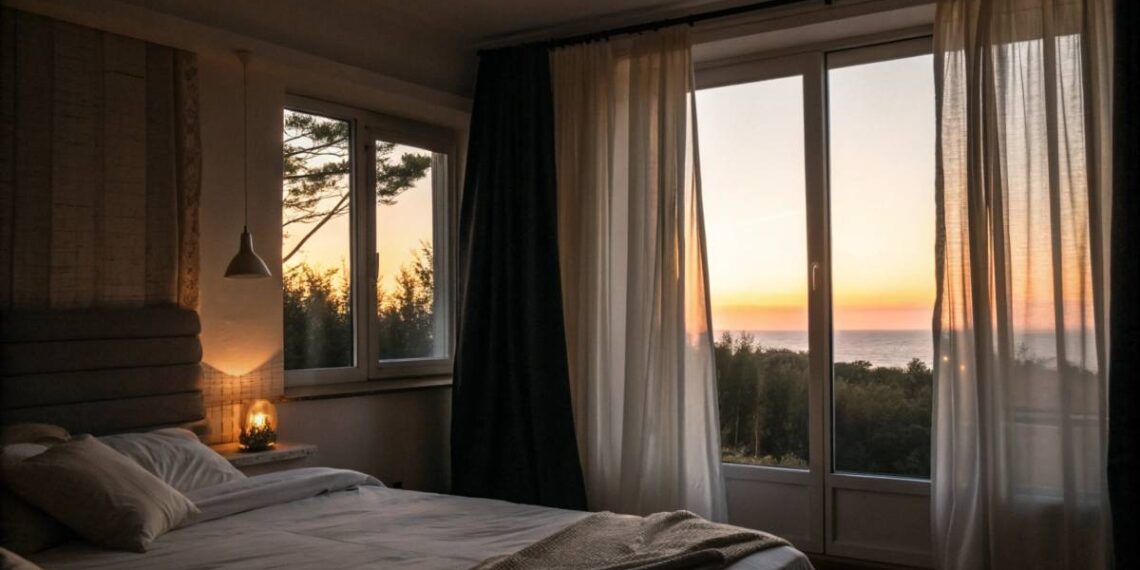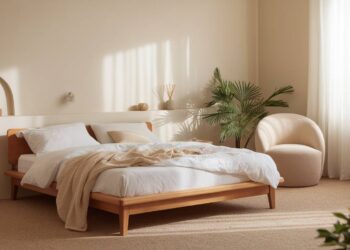Imagine drifting into a deep, restful sleep every night, waking up refreshed and energized. The secret might be simpler than you think—it’s all about the light. Light exposure plays a pivotal role in regulating your sleep patterns, mood, and overall well-being. Whether you’re a night owl struggling to wake up or someone looking to enhance sleep quality, understanding how to manage light can be your game-changer. Let’s explore how you can harness natural and artificial light to optimize your sleep and boost your health.
Key Takeaways
- Natural Light Synchronizes Your Circadian Rhythm: Morning sunlight acts as a natural reset for your internal clock, promoting better sleep cycles.
- Blue Light Disrupts Melatonin Production: Exposure to blue light from screens and artificial sources in the evening can hinder melatonin, making it harder to fall asleep.
- Creating a Sleep-Friendly Environment Enhances Sleep Quality: Utilizing blackout curtains, dimmable lights, and sleep-friendly bulbs can significantly improve your sleep hygiene.
- Consistent Light Management Routines Aid in Better Sleep: Establishing routines that control light exposure before bedtime helps maintain a stable sleep schedule.
Understanding the Impact of Light on Sleep
Turning off the lights and drawing the curtains might be more important than you think. Light plays a big part in how we sleep, so if you’re having trouble dozing off—whether you’re a night owl, a new parent, or stuck in a buzzing city—figuring out how light affects you might change everything.
“Light is the most powerful regulator of our biological rhythms, guiding us into wakefulness and sleep.” – Dr. Matthew Walker
Relationship Between Light and Internal Clocks
Ever heard of circadian rhythms? They’re like internal clocks that tell you when it’s time to sleep or wake up, repeating every day like a well-timed yawn. Light is their main trigger, keeping you matched up with nature’s schedule. Let’s see how:
| Light Exposure | Effect on Internal Clocks |
|---|---|
| Morning Light | Wakes you up and gets you going! |
| Daytime Light | Keeps you awake and holds off the sleepy hormone melatonin |
| Evening Light | Pushes back your bedtime by tampering with melatonin |
Catching some rays during the day helps these rhythms stay tuned, which is essential for decent sleep. Curious why the sun’s so helpful? Peek at our article on natural light and sleep.

Effects of Light on the Sleepy Hormone Stuff
Melatonin—ever heard of it? It’s the sleepy hormone. The pineal gland whips it up when it gets dark, signaling bedtime. Light exposure, however, plays a big role in this melatonin party.
| Light Exposure | Melatonin Levels |
|---|---|
| Bright Light (Daytime) | Not much sleepy juice |
| Dim Light (Evening) | Slowly ramps up sleepy juice |
| Darkness (Night) | Full-on sleepy juice mode |
Bright lights, especially those coming from screens and other man-made sources, can totally crash the melatonin bash and keep you staring at the ceiling (Blue Light’s Nasty Effects on Sleep). So, cutting down on these lights in the evening helps your body pump out that melatonin.
For ideas on making a sleep-friendly space that cuts down on artificial light, swing by our piece on perfect sleep environment. Getting the lowdown on how light messes with natural rhythms and the sleep hormone can lead you to better sleep habits and snooze-worthy rest.
Natural Light Exposure
Catching some rays can be a game-changer for snooze time. If you’re all about crafting the perfect sleep setup, getting the lowdown on how sunlight ticks all the boxes for your body is key.

Benefits of Natural Light
Natural light isn’t just about brightening up a room. It gives your brain a nudge, telling it when it’s time to hit the hay or start a new day. Here’s what soaking up some sun can do:
- Setting Your Inner Clock: Morning sunlight acts like a natural reset button, syncing your sleep with the earth’s cycle—a bit like nature’s way of saying, “Hey, it’s morning!”.
- Mood and pep booster: When you get a good dose of sunlight, it cranks up serotonin—the happy chemical—and wave goodbye to those sleepy blues.
- Fat Melatonin: Daylight exposure helps your body clock out melatonin so you can drift off to dreamland when the sun dips down.
| Benefit | What’s It Do? |
|---|---|
| Setting Your Inner Clock | Syncs sleep with natural rhythms |
| Mood and pep booster | Boosts serotonin to kick fatigue |
| More Melatonin | Helps you slip into sleep mode |
Mixing Sunlight in Your Day
Want to up your sleep game? Sunlight’s got your back. Here are some no-sweat moves:
- Catch That Morning Glare: Fancy a stroll in the A.M? Even a short outdoor jaunt can do wonders for resetting your sleep clock.
- Window Workstations: Park your desk near a window. All that daylight keeps your brain buzzing during work hours and sleepytime on track.
- Get Out and About: Got some spare time? Dive into the garden or break a sweat outdoors. It’s not just exercise but a sun-soaking opportunity.
- Light Up the Bedroom: Let the sunshine stream into your sleep space. Crank those curtains during the day, or opt for light, breezy ones if privacy’s your jam.
“Natural light is not only beneficial for our physical health but also essential for our mental well-being.” – Dr. Michael Breus
If nature’s light is scarce for you, figuring out how to deal with those artificial lights and their potential snooze-shredding ways is pretty important. Check out our scoop on crafting the ultimate sleep sanctuary.
Being mates with daylight does wonders for catching z’s and can be a real uplift to living well. For more tips on sleeping soundly, including how to find the perfect sleep temperature or keep the noise out of your nap zone, head over to our reads.

Artificial Light at Night
Artificial light at night messes with how well you snooze. Knowing what it does to your rest and figuring out how to dodge it can hugely boost your nights and help you feel better overall.
How Artificial Light Does You Wrong
That nighttime glow, especially from your phone, tablet, and all those glowing bulbs at home, can throw off your natural ability to catch some Zs. Here’s a bit of how it can mess things up:
| How it Messes with You | What’s Happening |
|---|---|
| Stops Melatonin | Shining blue light, like from phones, stops melatonin—the sleep hormone—from doing its thing. Makes falling asleep tough. |
| Choppy Sleep | Random spurts of light can cut your sleep into pieces, waking you up all night and leaving you groggy. |
| Late Sleepers’ Lament | Late-night light shifts your body’s internal time, making you a night owl that can’t sleep on time, especially if binge-watching before bed. |
| Stay Wide Awake | That light keeps you bright-eyed even when you want to chill and hit the hay. |
Beating Light Before Bed
If you wanna snooze better, dodge the shine before you toss and turn.
Easy Tips to Tone Down the Light:
- Dim the Glow: Start lowering those house lights in the evening to give your body the nudge that it’s shut-eye time.
- Cut the Screen Time: Power down devices at least an hour before bed. Try blue light filters if you must peek at the screen.
- Go Warm with Bulbs: Grab bulbs that glow warmer; they’ll mess less with melatonin and make a snuggly sleep space.
- Build a Chill Routine: Get away from bright screens. Unwind with a good old paperback or bubble bath. More tips in our article on setting up an ideal sleep space.
Light Sources and What to Do:
| Lights & Gadgets | How Bad They Are | What You Can Do |
|---|---|---|
| Phones/Tablets | Pretty Bad | Use blue light filters and swipe away an hour pre-bed |
| LED Bulbs | Bad to Worse | Dim ’em down or swap for warm bulbs as evening hits |
| PC Screens | Again, Bad | Same-old blue filters and limited use before beddy-bye |
| TVs | Not the Worst, But Still | Watch in low light, don’t get too close and cozy |
Taking these steps can spruce up your sleep no end and make you feel way more sprightly. City life got you struggling with outside glare? Try thick curtains to beat the streetlights.

Blue Light
Let’s chat about blue light and how it messes with your sleep. It’s that sneaky little wave of light that can stop you from snoozing peacefully. If you’re looking to get better z’s, knowing about this can be a game-changer.
Where’s Blue Light Hiding?
Blue light is like that annoying song you can’t get out of your head—it’s everywhere! From the sun to the gadgets glued to our hands. Spotting these sources will help you dodge it when it’s snooze time.
| Source | Blue Light Emission |
|---|---|
| Sunlight | Really High |
| LED and Fluorescent Lighting | Somewhere in the middle |
| Smartphones and Tablets | Sky High |
| Computer Screens | You guessed it, high |
| Televisions | Not as bad, but still too much |
To get away from blue light’s evil clutches in the evenings, think about using gadgets that jazz up your space without that harsh glow. Changing how long you stare at screens helps too.
How Does Blue Light Mess with Sleep?
Blue light is a sleep robber. It tampers with melatonin – that magic hormone that nudges us into dreamland.
| Effect | Description |
|---|---|
| Melatonin Suppression | Looking at blue light late keeps melatonin at bay, making it hard to nod off. |
| Circadian Rhythm Mix-Up | Too much blue light and your body’s clock goes haywire, ruining sleep time. |
| Hyper Alert Mode | It wakes you up just when you want to shut down for the night. |
Cutting back on blue light helps you sleep like a log. Easy fixes like dimming those blaring lights, using bulbs that are kinder to your sleepy eyes, or finding ways to filter this pesky light can make a world of difference.
Grasping blue light’s role and finding sneaky strategies to ease its effects can bring happier dreams for anyone—from night owls to shift workers. Working smarter, not harder, to control light exposure means more refreshing sleep awaits you.
Creating a Sleep-Friendly Environment
Fixing up your sleep zone is key to catching those sweet Z’s. A big piece of that puzzle is handling light exposure. Simple tweaks can go a long way to make your nights more restful.

Dimming Lights Before Bedtime
Think about your body’s way of knowing it’s time to chill out—dimming the lights! Less bright lights help your brain churn out melatonin, which nudges you toward dreamland. If you’ve got lamps with adjustable brightness, or cool dimmable lights, use them. They can flip your evening vibe to a soft and calming one.
| Time | Chill Light Level (lx) |
|---|---|
| 7:00 PM – 9:00 PM | 150 – 200 |
| 9:00 PM – 11:00 PM | 50 – 100 |
| After 11:00 PM | Below 50 |
Using Sleep-Friendly Light Bulbs
Light bulbs matter—avoid the ones spewing blue light all over the place. Pick warmer-toned bulbs instead. These won’t mess with your sleep mojo. Look for ones stamped “sleep-friendly,” and let ‘em cast that cozy glow around your bedroom.
| Bulb Type | Color Hue (K) | Blue Light Level |
|---|---|---|
| Standard LED | 4000+ | High |
| Warm LED | 2700 – 3000 | Low |
| Incandescent | 2700 | Very Low |
Implementing Light Control Hacks
Nailing light control hacks can seriously up your sleep game. Here’s what to try:
- Blackout Curtains: Keep the outside light out! A dark room is your sleep’s best pal. Check out our piece on blackout curtain perks for the full scoop.
- Smart Lighting Systems: Let your lights handle themselves. Have them dim slowly as your bedtime comes closer, keeping in step with your inner clock. Want to know more? Here’s our write-up on smart sleep gadgets.
- Nightlights: Need to be up at night? Use a gentle nightlight for the hall or bathroom that doesn’t wake you fully.
- Curtain Layers: Layer up those curtains to keep out light and help with temperature control—double win!
With these nifty light tricks and good sleep habits, your sleep zone will thank you. Sprucing up your night-time setup with these changes could mean sweet dreams ahead. Feel curious? Explore more tips on setting up your perfect sleep space, the ideal snooze temp, and plenty more.
Addressing Light Pollution
If bright lights are messing with your snooze time, you’re not alone—especially if you live in the city or near those glaring streetlights. Let’s dig into some smart moves to kick that light right out of your bedroom and make it just right for a good night’s sleep.
Stop Outside Light in Its Tracks
Artificial lighting from the outside can really throw off your internal clock. Kicking these beams to the curb is key for a peaceful snooze zone. Here’s how you can pull it off:
- Get Some Outdoor Light Shields: Slap on some shields or deflectors on outdoor lights to keep their glow pointed at the ground—no need for it spilling into your bedroom.
- Rejig Your Furniture Setup: Shift things around in your room so the bed isn’t catching all the light from outside.
- Plant Power: Throw in some houseplants near windows—they’ll not only cut some light but also freshen the air. Check out the list of best plants for a calming sleep.
Curtains and Blinds to the Rescue
When it comes to shutting out pesky light, some good ol’ heavy-duty curtains or blinds are your best buddies. They do an outstanding job of keeping your room nice and dark, just right for catching some Z’s.
| Curtain/Blind Type | How Good They Are at Blocking Light (%) |
|---|---|
| Blackout Curtains | 90-100 |
| Room Darkening Curtains | 70-90 |
| Light Filtering Shades | 20-70 |
Blackout curtains or room-darkening blinds can trick your brain into thinking it’s nighttime, no matter the hour. These are especially awesome for folks working night shifts or dealing with erratic sleep hours. Dive deeper into how blackout curtains can transform your sleep routine.
Putting these simple tricks to use can really up your sleep game by shutting out light hassles. For more sleep-friendly hacks, swing by our handy guide to achieving the perfect sleep haven.
Light and Sleep Hygiene
Getting the right amount of light can totally change how well you sleep. Having a regular bedtime thing and figuring out how to handle light can really help.
Establishing a Consistent Bedtime Routine
A bedtime routine is like a nightly signal for your body, telling it to chill out and get ready for snooze time. Regular habits tune your inner clock, making your sleep environment feel just right. Give these a try:
- Stick to the same sleep and wake-up times—even on lazy days.
- Do chill activities, like diving into a good book or soaking in a warm bath, before hitting the bed.
- Stay away from anything too exciting, like scrolling through phone apps, before you plan to sleep.
Incorporating Light Management Techniques for Better Sleep
Handling the light right is key to keeping your body’s internal clock ticking smoothly and catching better Z’s. Here’s how you can work with light:
- Dimming Lights Before Bedtime: Keep the lights low one hour before bedtime to nudge your brain into producing melatonin, which helps you feel sleepy.
- Using Sleep-Friendly Light Bulbs: Pick bulbs that shine warm and soft light. These won’t mess with your body’s signals to wind down.
- Implementing Light Control Strategies:
- Blackout Curtains: Install blackout curtains to keep unwanted light out.
- Smart Lighting: Try smart lighting that automatically gets dim or changes colors near bedtime.
- Avoiding Blue Light: Cut down on screen time or use blue light filters on your gadgets once evening rolls in.
Pair these light tips with a steady bedtime routine to really boost your sleep vibes and overall sleep quality. Check out how natural light and sleep shake up your sleep space to be just right.
| Strategy | Description |
|---|---|
| Set Bedtime Routine | Stick to a regular sleep schedule and calming pre-bed activities. |
| Dim Lights | Lower light exposure an hour before sleep time. |
| Use Sleep-Friendly Bulbs | Go for warm, soft light bulbs that encourage melatonin. |
| Control Light Exposure | Use blackout curtains, smart lighting, and cut back on blue light. |
Find more ways to build your dream zzz-zone with our guides on bedroom colors for sleep, declutter for better sleep, and the best bedding for sleep. Living in a noisy place? Our tips on soundproof bedroom tips might come in handy.
Main Tips
- Maximize Morning Sunlight Exposure: Spend at least 15 minutes outside in the morning to help reset your internal clock.
- Reduce Blue Light in the Evening: Use blue light filters on your devices or switch to warm-toned lighting after sunset.
- Optimize Bedroom Lighting: Install blackout curtains and use dimmable, sleep-friendly bulbs to create a calming sleep environment.
- Establish a Consistent Sleep Routine: Go to bed and wake up at the same time every day to maintain a stable circadian rhythm.
- Limit Screen Time Before Bed: Engage in relaxing activities like reading or meditation instead of using electronic devices before sleep.
Conclusion
Light is more than just a source of brightness—it’s a fundamental element that influences our biological rhythms and sleep quality. By strategically managing both natural and artificial light, you can sync your internal clock with nature’s cycles, boost your mood, and enhance your ability to fall asleep and stay asleep. Incorporating simple changes like exposing yourself to morning sunlight, reducing blue light exposure in the evenings, and optimizing your bedroom’s lighting can lead to significant improvements in your sleep patterns and overall health. Embrace these light management techniques to create a sleep-friendly environment that not only fosters restful nights but also energizes your days. Remember, a well-lit path to better sleep starts with understanding and controlling the lights around you.
FAQs
How does natural light affect my sleep cycle?
Natural light, especially in the morning, helps reset your internal clock, aligning your sleep-wake cycles with the natural environment, leading to more consistent and restorative sleep.
What is blue light and why is it bad for sleep?
Blue light is a high-energy light emitted by screens and certain bulbs. It suppresses melatonin production, making it harder to fall asleep and disrupting overall sleep quality.
What are blackout curtains and how do they help?
Blackout curtains are heavy, dark-colored drapes that block out external light. They create a dark environment conducive to sleep, especially in areas with significant light pollution.
Can using smart lighting systems improve my sleep?
Yes, smart lighting systems can gradually dim lights as bedtime approaches, mimicking natural sunset and signaling your body to prepare for sleep.
What are some tips to reduce blue light exposure in the evening?
Reduce screen time before bed, use blue light filters on devices, switch to warm-toned bulbs, and engage in relaxing activities away from screens to minimize blue light impact.
Resources
- National Sleep Foundation
- Harvard Health on Blue Light and Sleep
- Mayo Clinic’s Guide to Better Sleep
- Sleep Foundation on Circadian Rhythms
- CDC on Sleep and Health
Final Thoughts
Understanding the profound impact that light has on your sleep and daily life empowers you to make informed choices about your environment. By embracing natural light during the day and minimizing artificial light in the evening, you can enhance your sleep quality, mood, and overall health. Implementing these strategies doesn’t require drastic changes—small adjustments like optimizing your bedroom lighting, establishing consistent routines, and being mindful of screen time can lead to significant improvements. Prioritize your sleep by taking control of your light exposure, and enjoy the benefits of restful nights and energized days. Start your journey towards better sleep today by making light a key ally in your wellness routine.
Recommended Products and Accessories
- Philips Wake-Up Light Alarm Clock
- Enhance your morning routine with a wake-up light that simulates sunrise to gently wake you up.
- Govee Smart LED Light Bulbs
- Control your lighting with customizable colors and schedules to create the perfect bedtime environment.
- NICETOWN Blackout Curtains
- Block out unwanted light and noise with these high-quality blackout curtains, perfect for any bedroom.
- Blue Light Blocking Glasses by GammaRay
- Protect your eyes from blue light emitted by screens with stylish and effective blue light blocking glasses.
- Philips Hue Smart Lighting Starter Kit
- Create a smart lighting system that adapts to your sleep schedule and mood with customizable Philips Hue lights.







